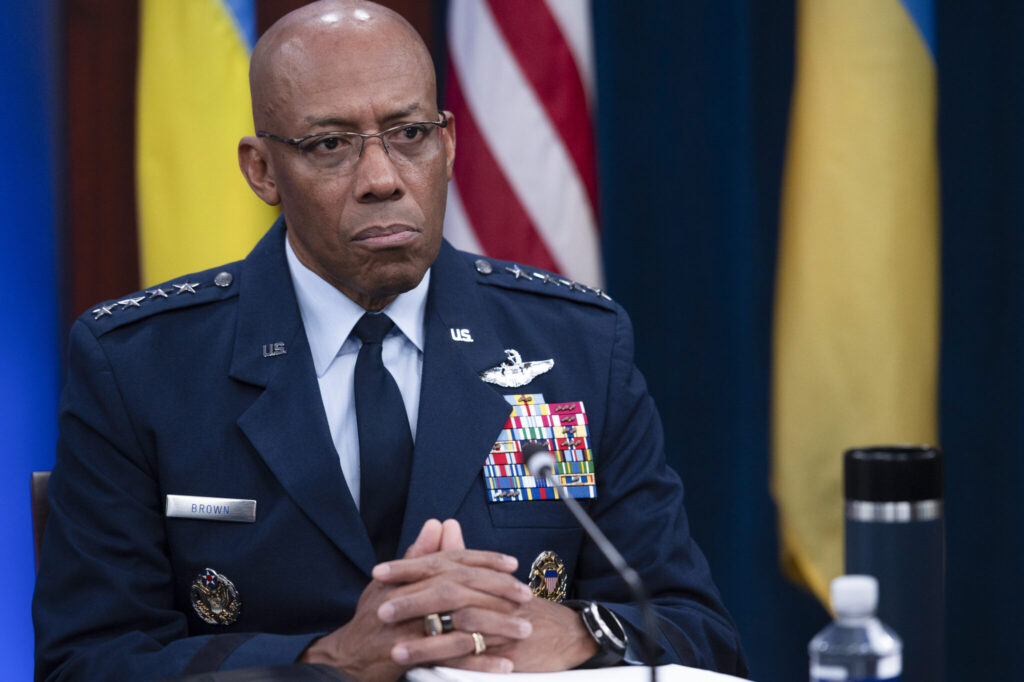The top two U.S. military leaders are traveling to Tel Aviv to advise the Israeli government on how to transition from major combat operations against Hamas in Gaza to a more limited and precise campaign — the kind of strategic shift they both have considerable expertise in. Defense Secretary Lloyd Austin and Joint Chiefs Chairman Gen. CQ Brown served in leadership roles as U.S. airpower and ground forces moved from major combat to lower-intensity counterterrorism operations in Iraq and Afghanistan. But it is not clear how deeply their advice from lessons learned will resonate with Prime Minister Benjamin Netanyahu’s government
Quick Read
- U.S. Military Leaders’ Visit: Defense Secretary Lloyd Austin and Joint Chiefs Chairman Gen. CQ Brown are traveling to Tel Aviv to advise the Israeli government on transitioning from major combat operations in Gaza to a more targeted campaign.
- Background Experience: Both Austin and Brown have experience in leading U.S. airpower and ground forces from major combat to lower-intensity counterterrorism operations in Iraq and Afghanistan.
- Israeli Government’s Stance: Prime Minister Benjamin Netanyahu’s government is focused on continuing its bombardment of Gaza until Hamas is fully destroyed, following the deadliest attack on Israel’s homefront on Oct. 7.
- Biden Administration’s Efforts: The Biden administration is increasing efforts to persuade Israel to scale back its offensive in Gaza, which has led to significant civilian casualties and displacement.
- Humanitarian and Strategic Concerns: The U.S. is concerned about Israel losing international support due to its indiscriminate bombing in densely populated areas and the use of civilians as human shields by Hamas.
- Pressure on Israel to Conclude Operations: U.S. officials have been advising Israel that its window for concluding major combat operations without losing more international backing is closing.
- Recommendations for Strategic Shift: Biden’s national security adviser, Jake Sullivan, suggested that Israel should shift to more targeted operations, focusing on high-value targets rather than broad bombardment.
- Israel’s Response: Israeli Defense Minister Yoav Gallant stated that Israel would continue major combat operations against Hamas for several more months.
- Implications for U.S. Military: The deployment of the USS Gerald R. Ford and another warship in the Mediterranean has been extended to maintain a two-carrier presence, primarily to deter Iran from escalating the conflict.
- Regional Military Activity: U.S. warships have been actively engaging in intercepting missiles and drones in the region, including attacks on commercial vessels in the Red Sea.
- Austin’s Expected Discussions: In his meetings in Israel, Austin is likely to discuss military campaign milestones with Israeli officials to assess when they can shift from major combat operations after sufficiently degrading Hamas.
- Austin’s Diplomatic Visits: Austin is expected to visit Bahrain and Qatar to work on establishing a maritime mission for increased security in the Red Sea and to facilitate negotiations related to the conflict.
The Associated Press has the story:
US Military Leaders head to Israel, will offer advice on shifting to war’s next phase in Gaza
Newslooks- WASHINGTON (AP)
The top two U.S. military leaders are traveling to Tel Aviv to advise the Israeli government on how to transition from major combat operations against Hamas in Gaza to a more limited and precise campaign — the kind of strategic shift they both have considerable expertise in.
Defense Secretary Lloyd Austin and Joint Chiefs Chairman Gen. CQ Brown served in leadership roles as U.S. airpower and ground forces moved from major combat to lower-intensity counterterrorism operations in Iraq and Afghanistan. But it is not clear how deeply their advice from lessons learned will resonate with Prime Minister Benjamin Netanyahu’s government
Israel is still stinging from the deadliest attack ever on its homefront and has pledged to continue its bombardment of Gaza until Hamas, which orchestrated the Oct. 7 attacks, is fully destroyed.

Their trip highlights the increased efforts by the Biden administration to convince Israel that it should scale back its offensive, which has flattened much of Gaza’s northern region, displaced millions and killed more than 18,700 Palestinians, according to the Health Ministry in the Hamas-run territory.
Israel’s push has been complicated by the dense urban population and Hamas’ network of tunnels, and the militants are accused of using civilians as “human shields.” The sustained intensity of Israel’s campaign has led President Joe Biden to warn that the U.S. ally is losing international support because of its “indiscriminate bombing.”
U.S. officials have been telling Israel for several weeks that its window is closing for concluding major combat operations in Gaza without risking the loss of even more backing.
In a meeting Thursday, Biden’s national security adviser, Jake Sullivan, urged Netanyahu to shift to more targeted operations by smaller military teams hunting specific high-value targets, rather than the sustained broad bombardment that has occurred so far. In response, Israeli Defense Minister Yoav Gallant said his country would continue major combat operations against Hamas for several more months.
There are implications for the tens of thousands of U.S. service members deployed in the region.

Austin on Friday extended the deployment once more of the aircraft carrier USS Gerald R. Ford and a second warship in order to retain a two-carrier presence in the Mediterranean Sea. The ships are seen as vital to deter Iran from widening the Israel-Hamas war into a regional conflict. The approximately 5,000 sailors aboard the Ford were originally due home in early November.
U.S. warships that were deployed with the Ford have intercepted incoming missiles fired toward Israel from areas of Yemen controlled by Iranian-backed Houthi rebels. They also have shot down one-way attack drones headed toward the ships and responded to calls for assistance from commercial vessels that have come under persistent Houthi attacks near the narrow Bab el-Mandeb Strait.
As of Friday, there are 19 U.S. warships in the region, including seven in the eastern Mediterranean. A dozen more stretched down the Red Sea, across the Arabian Sea and up into the Persian Gulf.
On Saturday, one of the warships assigned to the Ford carrier strike group, the destroyer USS Carney, “successfully engaged” 14 one-way attack drones launched from Houthi-controlled areas of Yemen, U.S. Central Command said in a statement. Britain reported that a Royal Navy destroyer downed another drone that was targeting commercial ships.
The missile and drone attacks have led at least two major shipping companies, Hapag-Lloyd and Maersk, to order their commercial vessels to temporarily pause transits through the strait.
“The recent attacks on commercial vessels in the Bab al-Mandeb Strait are alarming and pose a significant threat to the safety & lives of seafarers,” Maersk said in a statement posted to its official account on X, formerly known as Twitter, on Friday. “This issue cannot be addressed by the global shipping industry alone, and we urge the international society to come together to find a swift resolution to bring the situation under control.”
Austin is expected also to visit Bahrain and Qatar and further work toward establishing a new maritime mission to provide increased security for commercial ships sailing in the southern Red Sea. Bahrain is the home of the U.S. Navy’s Central Command headquarters and the international maritime task force charged with ensuring safe passage for vessels in the region.
Qatar has been vital in helping keep what has been a deadly localized war from boiling over into a regional conflict and negotiating hostage release.
Earlier in his Army career, Austin oversaw the drawdown of forces in Iraq in 2011. He visited Israel days after the Oct. 7 attack by Hamas and has spoken to Gallant, his Israeli counterpart, more than two dozen times since then.
In his meetings in Israel, he is likely to continue discussions on how Israelis define different military campaign milestones, to be able to assess when they will have sufficiently degraded Hamas to ensure their own security and shift from major combat operations, a senior U.S. defense official told reporters traveling with Austin.






